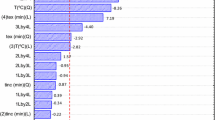Abstract
A novel and efficient headspace solid-phase microextraction (HS-SPME) method, followed by gas chromatography mass spectrometry (GC-MS), was developed to study volatile organic compounds (VOCs) emerging from microorganisms. Two homemade SPME fibers, a semi-polar poly (dimethylsiloxane) (PDMS) fiber, and a polar polyethylene glycol (PEG) fiber, along with two commercial fibers (PDMS and PDMS/DVB) were used to collect VOCs emerging from Clostridium tetani which was cultured in different media. The adsorbed VOCs were desorbed and identified, in vitro, using GC-MS. The adsorption efficiency was improved by optimizing the time duration of adsorption and desorption. About 50 components were identified by the proposed method. The main detected compounds appeared to be sulfur containing compounds such as butanethioic acid S-methyl ester, dimethyl trisulfide, and dimethyl tetrasulfide. These volatile sulfur containing compounds are derived from amino acids containing the sulfur element, which probably coexist in the mentioned bacterium or are added to the culture media. The developed HS-SPME-GC-MS method allowed the determination of the chemical fingerprint of Clostridium tetani volatile constituents, and thus provides a new, simple, and reliable tool for studying the growth of microorganisms.

Investigation of biogenic VOCs released from Clostridium tetani using SPME-GC-MS


Similar content being viewed by others
References
Sohrabi M, Zhang L, Zhang K, Ahmetagic A, Wei MQ. Volatile organic compounds as novel markers for the detection of bacterial infections. Clin Microbial Open Access. 2014; https://doi.org/10.4172/2327-5073.1000151.
Scott-Thomas AJ, Syhre M, Pattemore PK, Epton M, Laing R, Pearson J, et al. 2-Aminoacetophenone as a potential breath biomarker for Pseudomonas aeruginosa in the cystic fibrosis lung. BMC Pulm Med. 2010;10(1):56. https://doi.org/10.1186/1471-2466-10-56.
Shah N, Naseby D. Validation of constitutively expressed bioluminescent Pseudomonas aeruginosa as a rapid microbiological quantification tool. Biosens Bioelectron. 2015;68:447–53.
Tait E, Perry JD, Stanforth SP, Dean JR. Identification of volatile organic compounds produced by bacteria using HS-SPME-GC-MS. J Chromatogr Sci. 2014;52(4):363–73.
Tait E, Hill K, Perry J, Stanforth S, Dean J. Development of a novel method for detection of Clostridium difficile using HS-SPME-GC-MS. J Appl Microbiol. 2014;116(4):1010–9. https://doi.org/10.1111/jam.12418.
Zhang Z, Li G. A review of advances and new developments in the analysis of biological volatile organic compounds. Microchem J. 2010;95(2):127–39.
Thorn RMS, Reynolds DM, Greenman J. Multivariate analysis of bacterial volatile compound profiles for discrimination between selected species and strains in vitro. J Microbiol Methods. 2011;84(2):258–64.
Schulz S, Dickschat JS. Bacterial volatiles: the smell of small organisms. Nat Prod Rep. 2007;24(4):814–42.
Schöller CE, Gürtler H, Pedersen R, Molin S, Wilkins K. Volatile metabolites from actinomycetes. J Agric Food Chem. 2002;50(9):2615–21.
Bayn A, Nol P, Tisch U, Rhyan J, Ellis CK, Haick H. Detection of volatile organic compounds in brucella abortus-seropositive Bison. Anal Chem. 2013;85(22):11146–52.
Mochalski P, Theurl M, Sponring A, Unterkofler K, Kirchmair R, Amann A. Analysis of volatile organic compounds liberated and metabolised by human umbilical vein endothelial cells (HUVEC) in vitro. Cell Biochem Biophys. 2015;71(1):323–9.
Preti G, Thaler E, Hanson CW, Troy M, Eades J, Gelperin A. Volatile compounds characteristic of sinus-related bacteria and infected sinus mucus: analysis by solid-phase microextraction and gas chromatography-mass spectrometry. J Chromatogr B. 2009;877(22):2011–8.
Lubes G, Goodarzi M. Analysis of volatile compounds by advanced analytical techniques and multivariate chemometrics. Chem Rev. 2017;117:6399–−422.
Es-haghi A, Hosseininasab V, Bagheri H. Preparation, characterization, and applications of a novel solid-phase microextraction fiber by sol-gel technology on the surface of stainless steel wire for determination of poly cyclic aromatic hydrocarbons in aquatic environmental samples. Anal Chim Acta. 2014;813:48–55.
Es-haghi A, Baghernejad M, Bagheri H. In situ solid-phase microextraction and post on-fiber derivatization combined with gas chromatography-mass spectrometry for determination of phenol in occupational air. Anal Chim Acta. 2012;742:17–21.
Es-haghi A, Baghernejad M, Bagheri H. Novel unbreakable solid-phase microextraction fibers on stainless steel wire and application for the determination of oxadiargyl in environmental and agricultural samples in combination with gas chromatography-mass spectrometry. Talanta. 2014;128:231–6.
Fratelli F, Siquini TJ, de Abreu ME, Higashi HG. Fed-batch production of tetanus toxin by Clostridium tetani. Biotechnol Prog. 2010;26(1):88–92.
Acknowledgements
Financial support for this project was provided by the Research Council of Razi Vaccine and Serum Research Institute (RVSRI). Special thanks to human bacterial vaccine department for their help. Also, we thank Dr. F. Madani and A. Maarefvand for their kind help.
Author information
Authors and Affiliations
Corresponding author
Ethics declarations
This study did not involve research on human participants or animals.
Conflict of interest
The authors declare that they have no conflict of interest.
Electronic supplementary material
ESM 1
(PDF 259 kb)
Rights and permissions
About this article
Cite this article
Ghader, M., Shokoufi, N., Es-haghi, A. et al. Sol-gel-based SPME fiber as a reliable sampling technique for studying biogenic volatile organic compounds released from Clostridium tetani . Anal Bioanal Chem 409, 6739–6744 (2017). https://doi.org/10.1007/s00216-017-0675-1
Received:
Revised:
Accepted:
Published:
Issue Date:
DOI: https://doi.org/10.1007/s00216-017-0675-1




